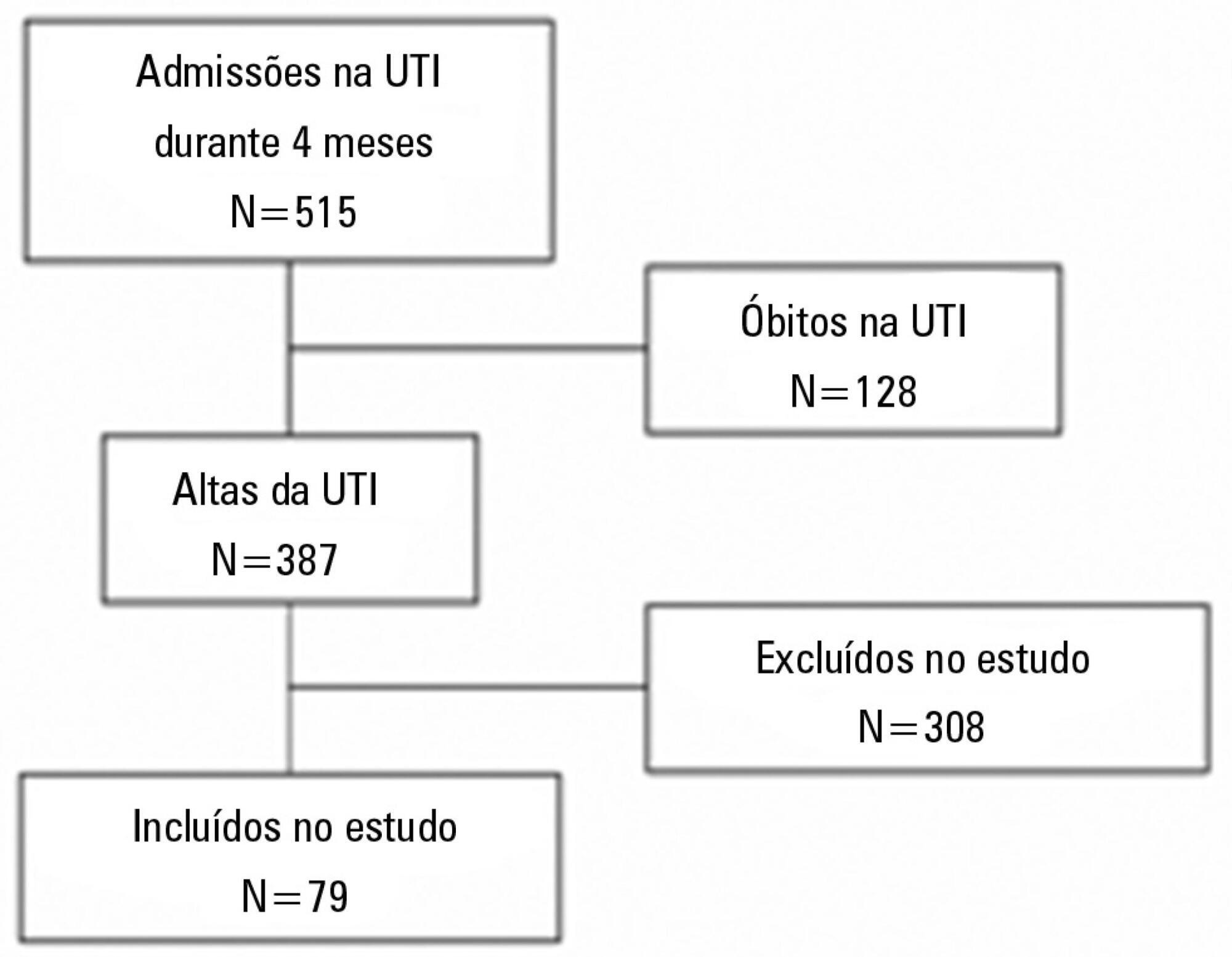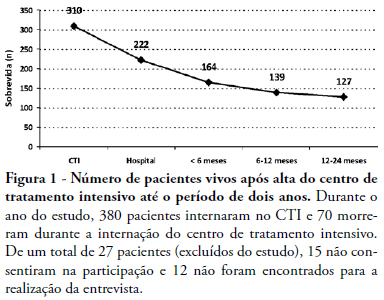Abstract
Rev Bras Ter Intensiva. 2012;24(4):341-346
DOI 10.1590/S0103-507X2012000400008
OBJECTIVE: To examine the reliability of the SF-36 general health questionnaire when used to evaluate the health status of critically ill patients before admission to intensive care and to measure their health-related quality of life prior to admission and its relation to severity of illness and length of stay in the intensive care unit. METHODS: Prospective cohort study conducted in the intensive care unit of a public teaching hospital. Over three months, communicative and oriented patients were interviewed within the first 72 hours of intensive care unit admission; 91 individuals participated. The APACHE II score was used to assess severity of illness, and the SF-36 questionnaire was used to measure health-related quality of life. RESULTS: The reliability of SF-36 was verified in all dimensions using Cronbach's alpha coefficient. In six dimensions of eight domains the value exceeded 0.70. The average SF-36 scores of the health-related quality of life dimensions for the patients before admission to intensive care unit were 57.8 for physical functioning, 32.4 for role-physical, 53.0 for bodily pain, 63.2 for general health, 50.6 for vitality, 56.2 for social functioning, 54.6 for role-emotional and 60.3 for mental health. The correlations between severity of illness and length of stay and the health-related quality of life scores were very low, ranging from -0.152 to 0.175 and -0.158 to 0.152, respectively, which were not statistically significant. CONCLUSION: In the sample studied, the SF-36 demonstrated good reliability when used to measure health-related quality of life in critically ill patients before admission to the intensive care unit. The worst score was role-physical and the best was general health. Health-related quality of life of patients before admission was not correlated with severity of illness or length of stay in the intensive care unit.
Abstract
Rev Bras Ter Intensiva. 2013;25(3):218-224
DOI 10.5935/0103-507X.20130038
To assess the functional and psychological features of patients immediately after discharge from the intensive care unit.
Prospective cohort study. Questionnaires and scales assessing the degree of dependence and functional capacity (modified Barthel and Karnofsky scales) and psychological problems (Hospital Anxiety and Depression Scale), in addition to the Epworth Sleepiness Scale, were administered during interviews conducted over the first week after intensive care unit discharge, to all survivors who had been admitted to this service from August to November 2012 and had remained longer than 72 hours.
The degree of dependence as measured by the modified Barthel scale increased after intensive care unit discharge compared with the data before admission (57±30 versus 47±36; p<0.001) in all 79 participants. This impairment was homogeneous among all the categories in the modified Barthel scale (p<0.001) in the 64 participants who were independent or partially dependent (Karnofsky score ≥40) before admission. The impairment affected the categories of personal hygiene (p=0.01) and stair climbing (p=0.04) only in the 15 participants who were highly dependent (Karnofsky score <40) before admission. Assessment of the psychological changes identified mood disorders (anxiety and/or depression) in 31% of the sample, whereas sleep disorders occurred in 43.3%.
Patients who remained in an intensive care unit for 72 hours or longer exhibited a reduced functional capacity and an increased degree of dependence during the first week after intensive care unit discharge. In addition, the incidence of depressive symptoms, anxiety, and sleep disorders was high among that population.

Abstract
Rev Bras Ter Intensiva. 2009;21(3):299-305
DOI 10.1590/S0103-507X2009000300010
OBJECTIVE: To investigate the relationship between work and quality of life of doctors and nurses in pediatric intensive care units and neonatal. METHODS: Cross-sectional study with 37 doctors and 20 nurses. The Job Content Questionnarie (JCQ) e Effort-Reward Imbalance (ERI), and World Health Organization Quality of Life (WHOQOL-100) were used. The correlation was estimated by Spearman correlation coefficient. RESULTS: The effort is inversely correlated with the areas physical, psychological, level of independence, environment (p<0.01) and social relationship (p<0.05). The reward is inversely correlated with the areas and psychological (p<0.05) level of independence (p<0.01). Control over the work is directly correlated with the physical domain (p<0.05). The psychological demands are inversely correlated with the areas physical (p<0.05), psychological (p<0.01) and level of independence (p<0.01). The physical demand is inversely correlated with physical areas, level of independence, environmental (p<0.01) and psychological (p<0.05). Job insecurity is inversely correlated with the psychological fields, level of independence (p<0.05) and the environment (p<0.01). Support the supervisor is directly correlated with degree of independence (p <0.05). CONCLUSION: Doctors and nurses showed high efforts, demands psychological, physical and job insecurity that impact on quality of life.
Abstract
Rev Bras Ter Intensiva. 2009;21(1):18-24
DOI 10.1590/S0103-507X2009000100003
OBJECTIVES: To evaluate mortality and long term quality of life of patients who were discharged from the intensive care unit. METHODS: A prospective cohort, in which all the admitted patients in a intensive care unit (ICU) during 6 months were evaluated and interviewed by telephone after two years of discharge, aiming the completion of two quality of live scales: Karnofsky scale and activities of daily living (ADL) scale. RESULTS: From a total of 380 patients, 100 (26.5%) individuals were alive at the time of interview, 94% living in their homes and 90% without the need for family or specialized care. There was a significant reduction in quality of life of the survivors (Karnofsky pre-ICU = 90±10 vs. Karnofsky after two years = 79±11; p<0.05), although maintaining their functional capacity (ADL pre-ICU = 28±4 vs. ADL after two years = 25±8; p=0.09). This drop in the quality of life occurred mainly to patients who suffered stroke (Karnofsky pre-ICU = 88±7 vs. Karnofsky after two years = 60±15; p<0. 01). CONCLUSION: These preliminary data suggest that the performance of patients after two years of the intensive care discharge is preserved, since they retain the ability to perform self care, except in those with brain damage which shows an inferior quality of life.

Abstract
Rev Bras Ter Intensiva. 2007;19(1):60-66
DOI 10.1590/S0103-507X2007000100008
BACKGROUND AND OBJETIVES: To evaluate the quality and satisfaction of life (QSL) of patients before admission in ICU, and after hospital discharge. To verify the influence of the patient's demographic/clinic/therapeutic factors in the QSL. METHODS: Prospective cohort study with quali-quantitative approach. All patients admitted in ICU/HU/UFSC from April-July 2005, who's stayed more than 24 hours were included. Initially, the data of QSL before ICU admission, patient's demographics/clinics/therapeutics features were recorded. Afterwards, by telephone, 7, 90 and 180 days after hospital discharge, the patients answered the questionnaires about QSL. In the sequence, all patients were subdivided into 2 main groups: unchanged or better, and worse QSL. Data were analyzed using t Student and Chi-square tests (p-value < 0.05). RESULTS: Sixty eight patients were enrolled into the study. Completed questionnaires were obtained from 21 of them. A comparison of 7, 90 and 180 days after hospital discharge showed that QSL of patients was unchanged or better at 90 and 180 days. The majority of patients expressed more satisfaction in that moment. Unchanged or better QSL was associated with advanced age. However, there were no statistical significant differences in sex, schooling, APACHE II score, length of stay, mechanical ventilation and used drugs. Sixty percent returned to their previous work. CONCLUSIONS: There was a tendency for patients who felt themselves satisfied after hospital discharge to have their QSL improved as time went bye. Better QSL was associated with advanced age. Even when patients reported worse QSL they returned to their previous work.
